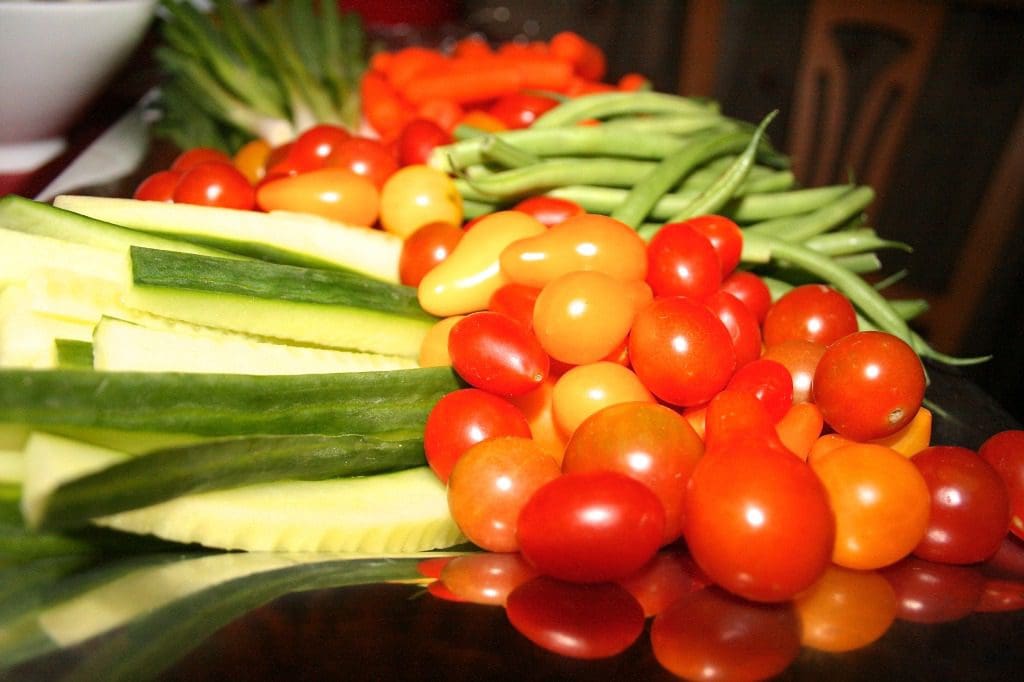
Contributed by Elizabeth Payne
LOS ANGELES, CA, November 19, 2015 – Crudité is French for veggies and dip, and like many things, it just sounds yummier in French- most probably because “veggies and dip” conjures unpleasant images of veggie trays from your local big box store. You know the one… with the dried out carrot nubs, the broccoli florets that smell “off” and the watery ranch dip. Who wants to eat that? No one! That’s why the evening ends with the host sneaking the picked-over tray into an unsuspecting guest’s “to go” bag. And that’s a shame because a crudité platter is not only good for you, but when done right it’s also glorious.
Like its hors d’oueveres brethren, the cheese plate and charcuterie board, crudité is an easy, no-cooking option that can be put together on a moment’s notice. In a pinch, you can whip up a darn tasty crudité platter with one trip to the grocery store and 10 to 15 minutes prep time. These days most grocery stores have an organic or local food section in the produce department; it’s a good place to look for flavorful options. But if you want delicious, the kind of delicious that will get even a confirmed veg-o-phobe scarfing down the contents of your crudité platter, you’ve got to get a little creative. Break out of the store bought hummus box, and think beyond carrots and celery. You’ve got to explore your local produce market or organic grocery or better yet take a trip to the farmer’s market. Until you know what’s available, you won’t be able to plan your veggie selection because the quality of your crudité platter depends first and foremost on the quality of your produce. So, regardless of whether you’re at the Safeway or the farmer’s market, here are a few things to keep in mind.
The Vegetables
An assortment of 4 to 5 different vegetables
Seasonality
- Buy things that are in season; they’ll taste better.
- If you don’t know, ask. Produce managers and farmers generally LOVE talking shop… and will frequently give samples.
- Even in the winter there are options: Beets, Cauliflower, Kale, Fennel, Carrots, Mushrooms… to mention a few
Think contrast: different colors, different textures
Look, Smell, Touch
- Look the merchandise over; it doesn’t have to be perfect, but bruising, shriveling, rot or invasive critters are often a good sign that something is amiss.
- Smell it! The vegetable should be fragrant. It’s the best indicator as to whether it will have any flavor.
- Pick it up. The vegetable should feel heavy for it’s size and have a firm skin. That means it’s still got plenty of water in it. Like humans loss of moisture and wrinkled skin mean the vegetable may be past its prime.
Of course, no crudité platter is complete without something luscious to dip all those beautiful veggies into. But here’s the thing; dip should complement and accentuate the vegetables, not mask the fact that you’re eating flavorless produce that’s been warehouse ripened with ethylene gas. In a rush, feel free to pick something up at the supermarket. If you’re able to plan a few days in advance, consider making a dip or two.
The Dip
At the store there are options beyond ranch dressing
- The multitude of hummus variations- pick one you like, not all hummus is created equal.
- Other readily available Mediterranean style dips like tzatziki or baba ganouj
- Pesto
- A prepared herb cheese like Boursin- bring it to room temperature and then loosen it up with a tablespoon of olive oil or mayo. You can do the same with pimento cheese spread.
- Jarred salad dressings from the refrigerator case
At home… the options are endless. Chef Mary has a few suggestions. Yum!
- Roasted Red Pepper and Garlic Dip
- Lemon/Basil Aioli
- Spinach and Artichoke Dip- Put down the soup packet! This is way beyond the bread bowl standard.
The Prep
Wash the vegetables.
- They grow in the ground. They have dirt on them.
To peel or not to peel
- With young baby carrots, beets, etc. the skin is delicate enough that it can be left on.
- With larger, older specimens, it’s probably best to peel them.
To blanch or not to blanch**
- This technique is frequently used on things like green beans, sugar snap peas, asparagus, and brussel sprouts.
- It’s a personal choice, but it can enliven older, tougher veggies.
Make the veggies easy to grab, dip and munch.
- This means seeding and cutting things like bell peppers into strips.
- Broccoli and cauliflower florets should not be so large that you can’t get them into your mouth.
- The same goes for slices of cucumber, summer squash, etc.
Arrange artfully on a platter.
And dig in!
**Blanching is a culinary technique whereby vegetables are plunged into boiling, salted water for a minute or two, then drained and plunged into an ice water bath to halt the cooking process. The vegetable is rendered “crisp-tender,” and both it’s color and flavor are intensified.
If you liked this article check out our how to make a charcuterie platter